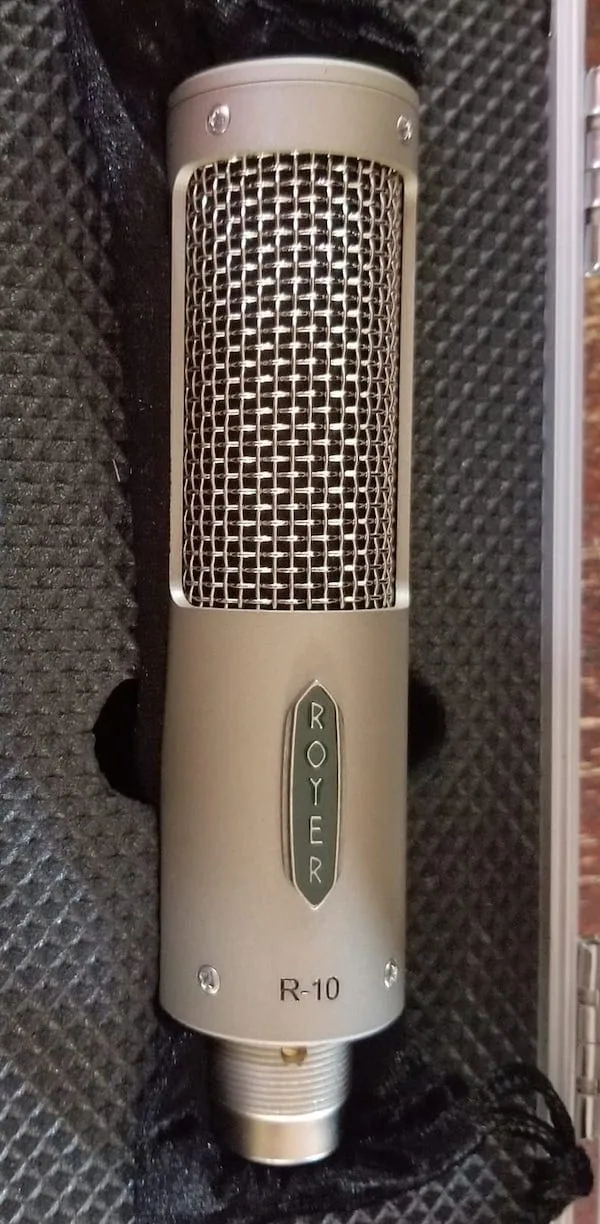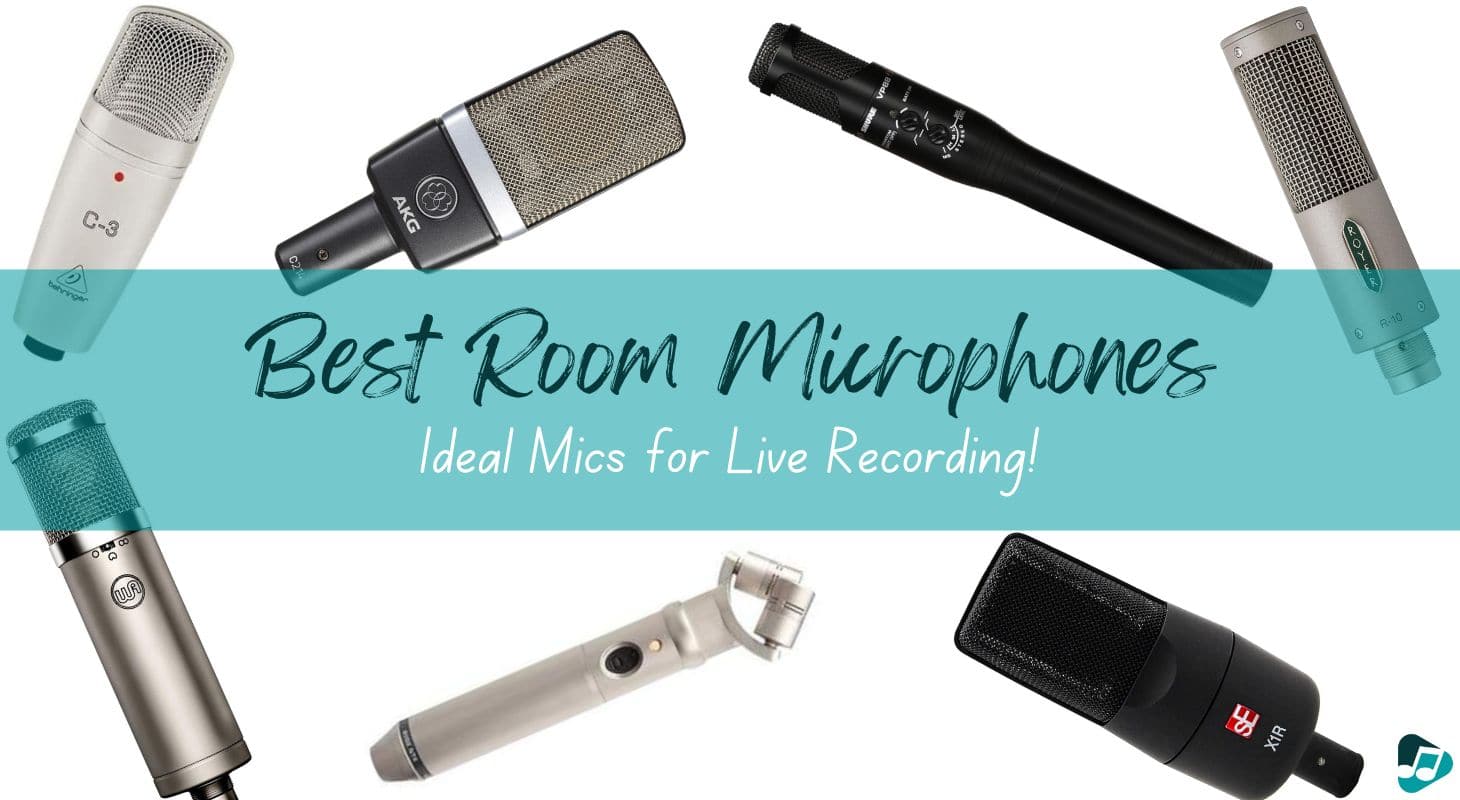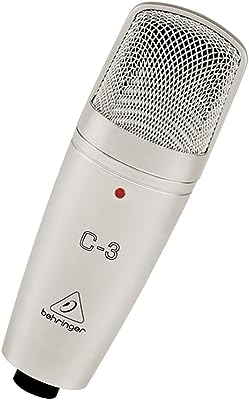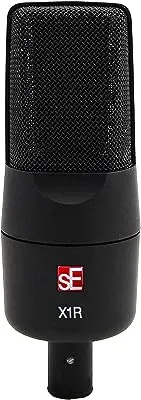I must say, many producers today are missing out on something significant when they solely rely on digital audio workstations and samples to create their tracks. And that is the recording of real instruments in a physical space!
Sure, sample libraries are amazing, but let's not forget that they are made with tons of microphones and in some seriously sweet rooms.
Take drum libraries, like XLN Audio's Addictive Drums, for example. When you purchase one of those, you're not only getting a bunch of drum sounds but also a top-notch drum set that has been recorded by a professional engineer in an amazing space that's sometimes even legendary.
Of course, many of us still record live instruments in studios or bedrooms all the time. But if you're just starting out, it's definitely worth investing in a great room microphone to get the best sound possible. Trust me, it'll make a huge difference!
7 Excellent Room Mics for Live Recording!
1. AKG C414 XLII
The AKG C414 is a classic mic used on thousands of recordings. But the C414 XLII is even better for room miking because they've mixed in some of the sonic character of AKG's greatest mic, the C12.
The C12 mic always rocked for drum ambiance. So, in addition to the C414's beautiful high-end crispness, which it's known for, this combo is a match made in heaven.

AKG C414 XLII
Bright mics like this one work well on drum overheads and room mics because they help counteract the hollow reflection you get from drums in confined or treated spaces. Personally, I love compressing and even saturating drum room mics a little bit to bring out that pop sizzle that's amazing on a lot of these rock records.
The AKG C414 is perfect for capturing that. It also works great on live piano because it has such a great transient response. If you want that pop or singer-songwriter, modern piano sound, look no further.
Another cool thing about this mic is the added bass cut or high-pass filters. There’s a 12 dB filter cut at 40 Hz and 80 Hz, and they also put a 6/dB option, which is slightly smoother and more forgiving at 160 Hz.
The only thing that might trip up someone using this mic for the first time as a room mic is that it’s possible to actually get a very thin sound because it's bright. If you're just learning how to position mics, be very careful with the placement.
2. Royer R-10
The Royer R-10 is a ribbon microphone that is much more sensitive than an average condenser microphone due to its ribbon transducer design. You can use it for room recording or a combination of close-mic techniques and room recording.

Royer R-10
This ribbon microphone can handle sounds up to 160 dB, making it perfect for loud environments. The R-10 is especially great for capturing metal bands, large brass ensembles in smaller spaces, and percussion.
Ribbon microphones provide a smooth, natural-sounding high-end, which is ideal for capturing transients. They also work well for ambient drum mixing, percussion, and sound effects in Foley.
The R-10 also has a figure-8 configuration that is perfect for room recording. It captures sound from the front and back of the capsule simultaneously, unlike most microphones that only capture sound from one direction. If you place this microphone in the center of a room, you can get a tight, present signal and a nice reflection of the room itself.
It would have been cool for Royer to sell the R-10 in matched stereo pairs with consecutive serial numbers. They sell matched pairs of other microphones, such as the C414 XL II, so why not?
It is important to have microphones with sequential serial numbers if you plan on using them for room recording and stereo applications. Even microphones from the same factory and brand can sound quite different if they are not matched.
If you can purchase two R-10s, it might be worth asking if you can get consecutive serial numbers.
3. Behringer C-3
Behringer has come a long way from being a brand for budget-conscious consumers to becoming a brand known for producing quality yet affordable instruments and equipment. The Behringer C-3 is a medium dual-diaphragm studio condenser microphone that can do a lot of things because of its three capsule patterns - cardioid, omnidirectional, and figure 8.

Behringer C-3
When it comes to room acoustics, the omnidirectional and figure 8 patterns work well. The Omni microphone captures a 360-degree sound picture of the space, making it perfect for bands positioned around the room.
Figure 8 also works well, but it focuses more on the front and back and less on the sides, unlike the omnidirectional.
This mic is great for overhead drums and piano, with a robust maximum sound pressure level of 142 dB and low noise specifications for a condenser microphone. It also has a transformerless design using FET inputs that eliminate a lot of low-frequency distortions.
Having low self-noise mics is crucial when miking live rooms because there tends to be a lot of floor noise due to electromagnetic static from buzzing amps and general ambient noise. Thus, you do not want to add any potential hiss or static from the mic itself.
The only downside to this mic is that its frequency range is limited on the top end, going from 40 Hz to 18 kHz. If you want to capture something like strings, piano, or the nice sizzle from the cymbals of a drum set, cutting off at 18 K might seem a little disappointing.
4. Warm Audio WA-47Jr
Warm Audio is the king of building affordable replicas of expensive studio equipment. The WA-47jr pays tribute to the classic Neumann U47, which was used by famous artists like Frank Sinatra and Sting. Unlike the original, the WA-47jr is a solid-state transformer mic with a three-polar pattern design of cardioid, omni, and figure 8.
I also love the beautiful, vintage Neumann-esque appearance of this microphone. Its quality is evident, and it looks high-end, which can't hurt if you have clients or record company executives at your session.

Warm Audio WA-47Jr
Solid-state mics are great for picking up transients with very little distortion, making them perfect for miking up a room. Tube mics, on the other hand, are known for their warm sound and are great for vocals but can be noisy for room configurations.
The WA-47jr is excellent for recording piano, choir, room, percussion, overhead, and ambient mics. Warm Audio even added a 70Hz high-pass filter to the mic to help counteract the warmth and darkness of the original Neumann U47, which is known for being a little warmer and darker on the high end and having a fatter midrange.
I have used this mic before, and although it claims to have a frequency response range of 20Hz-20kHz, I found it to be a little too dark and dull in the highs. This could be due to solid-state mics having more total harmonic distortion, which adds a bit of sizzle to the top harmonics. However, sometimes, solid-state mics lack a little bit of character in the high end.
5. Rode NT4
To get a good stereo recording of a room, you should use a stereo microphone setup. If you can get one with an XY configuration already set, you'll save yourself from having different sounding left and right sides by trying to use different mono microphones. Even if it's off by just a couple of degrees, it can mess up your sound.
Rode has truly outdone itself with the creation of the NT4 stereo microphone, which has become a lifesaver for many inexperienced engineers. This microphone boasts of a single pattern, XY Stereo, that's been designed in the shape of two mini-pencil microphones that intersect each other in an XY formation.

Rode NT4
The microphone may seem basic, but it performs incredibly well. The sound is clean, natural, and neutral, making it difficult to find anything better. It is suitable for both beginners and professionals, which is why so many engineers appreciate it.
The NT4 is especially good for brighter sounds like Latin horn sections, small percussion, shakers, and acoustic guitars. If you're a guitar player and you want to capture a nice live performance, maybe on a classical or nylon string guitar, this is the microphone for you. It has a natural response and can handle percussive and plug signals really well.
The only thing missing on this microphone is a low-cut high-pass filter option. Just a very delicate cut, maybe around 40Hz, would have been useful when recording in an environment with some air conditioning or street noise.
6. sE Electronics X1 R
If you're looking for affordable, yet classic studio equipment designs, consider checking out sE Electronics. This company offers a great lineup of products that can rival Behringer and Warm Audio in terms of pricing.
One of their standout offerings is the X1 R, a highly regarded passive ribbon microphone that delivers excellent sound quality at a fraction of the cost of other established brands such as Royer.
This microphone is seriously sensitive and has a totally natural sound - it's the perfect addition to your recording setup, whether you're a pro sound engineer or a wannabe rockstar.
What's cool about this microphone is that it has an extended upper range, going up to 16 kHz. Most ribbon microphones start rolling off high-end frequencies around 10 kHz to achieve a smooth, natural sound, so this is pretty unique.
It's one of the brighter ribbon microphones out there but still sounds great. Keep in mind that it only has a figure-8 configuration, which might not be ideal for all recording situations. However, it's perfect for room microphones, acoustic instruments, vocals, and drum overheads.
The only downside is that it's a passive ribbon microphone, so you'll need a preamp with high impedance and a lot of gain to avoid noise issues. But, hey, you're saving money on the microphone itself, right?
Compared to other microphones, like the Royer or the SPL, the X1 R has a maximum SPL of only 135dB, so you might encounter some problems recording loud bands and distorted amps in smaller spaces.
7. Shure VP88
Shure always delivers awesome real-life solutions with their microphones. Their dynamic microphones are perfect for touring, and their studio microphones are seriously top-notch.
The VP88 is an excellent room microphone and is cooler than some other stereo microphones out there. It has a switchable three-way control for the stereo dimension, so you can capture a narrow or wide stereo field, or even use MS (mid-side) processing for more control.

Shure VP88
Mid-side processing is super popular now, with companies like Izotope and Plugin Alliance making tons of mastering plugins with mid-side options. It gives you more control over the spread of the stereo field.
This microphone is perfect not just for recording studios and live rooms, but also for broadcast rooms or discussions with multiple speakers from different angles. Mid-side processing has much to do with the spread and phasing characteristics of the stereo field, allowing for a more natural image of the total room.
Additionally, as a product of a company like Shure, it is built to last. This microphone is ideal for remote travel and capturing audio in different rooms while experimenting. It is also great for capturing audio during video performances.
However, since the VP88 focuses more on stereo imaging than transient response, it might not be the best choice for capturing solo instruments like piano, drums, or guitar. Its SPL is also relatively weak, maxing out at 129 dB. Overall, it's better for capturing an overall room image.
Choosing the Best Room Mic for Your Use Case
I feel like a lot of times musicians struggle with choosing their gear because we're always thinking about all the different scenarios we might need to be ready for, but we don't always know exactly how we're gonna use the gear.
Room mics are a perfect example of this because they're super important for getting top-notch, natural recordings of performances. But unless you're a seasoned engineer who's been in the game for a while, they might not be the easiest thing to wrap your head around as a singer or instrumentalist.
So, here are some tips to help you make a smart choice when it comes to room mics:
Microphone Type
So, first things first: what kind of microphone(s) do you want to use? Do you want a solo mic, a stereo mic, or two mono ones? Investing all your money in a stereo mic might not be the best idea, since it could be too limiting.
Going for two mono mics might be more useful - you can always use them for two people or two instruments in mono instead of just having one stereo signal from far away.
Another thing to keep in mind is that if you want to use mono mics and have different options for stereo configuration, you need to get a stereo-matched pair with consecutive serial numbers. But this might be a bit tricky when buying from retailers - they might sell mono mics without checking their serial numbers, causing them to sell matched pairs to different people.
Sensitivity
When you're picking out a microphone, you have to think about how sensitive you want it to be. You have two options: a ribbon mic or a condenser mic. Ribbon mics are very sensitive and can handle louder sounds pretty well.
However, they don't always pick up all the higher frequencies. So, if you're thinking about sensitivity and ribbon mics, you have to figure out if it's really going to make a big difference in how you work, and if it’s worth sacrificing top-end detail.
Polar Patterns
If you don't have the cash to buy multiple microphones, polar patterns are where you'll get the most value for your money. The more polar patterns you have, the more ways you can capture the overall feel of the room.
Personally, I believe that more options are better. However, the tradeoff is that sometimes you sacrifice sound quality for versatility. Keep in mind that certain polar patterns, such as Figure 8, can affect the sound if you don't know how to manage room acoustics.
Closing Thoughts
So, in my personal experience, one of my absolute favorite things to do is to have jam sessions with other people. Especially during the pandemic when everything was remote and I was recording over Zoom, I really felt that lack of connection and the fun that you have when lots of people, or even just a few, are playing together in the same room.
Also, most of the best musical moments I've ever recorded were captured using a stereo microphone setup, including rehearsals in a room before the official recording. I've actually kept and released stereo recordings of things that happened before we were going to do the official recording, and I was only able to capture them properly, and to a good enough level for mixing and releasing because I always have several pairs of stereo mics going in my live room at all times.
This is a trick I learned from one of my mentors and heroes, Daniel Lanois. When he recorded Bob Dylan's "Time Out of Mind" record, he basically made the whole band, including Bob Dylan, play in one room and got all the magic of the takes in real time. The record blew my mind and really inspired me to use more stereo performance room mics.
I believe that having a high-quality stereo microphone setup in whichever room you guys are in could be a game-changer for your inspiration and future recordings.








